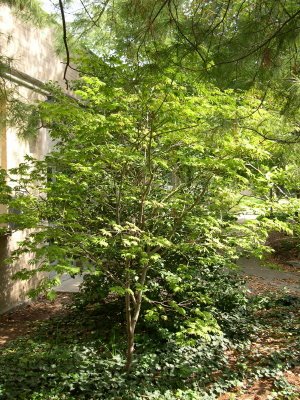Facts about Trees I

Picture of Acer japonicum Aureum
General
- Trees keep our air supply fresh by absorbing carbon dioxide and producing oxygen.
- In one year, a single tree can absorb as much carbon as is produced by a car driven 26,000 miles.
- Trees provide shade and shelter, reducing yearly heating and cooling costs by 2.1 billion dollars.
- Trees lower air temperature by evaporating water in their leaves.
- The average tree in metropolitan area survives only about 8 years!
- A tree does not reach its most productive stage of carbon storage for about 10 years.
- Trees cut down noise pollution by acting as sound barriers.
- Tree roots stabilize the soil and prevent erosion.
- Trees improve water quality by slowing and filtering rain water as well as protecting aquifers and watersheds.
- Trees provide protection from downward fall of rain, sleet, and hail as well as reduce storm run-off and the possibility of flooding.
- Trees provide food and shelter for wildlife.
- Trees located along streets act as a glare and reflection control.
- The death of one 70-year old tree would return over three tons of carbon to the atmosphere.
Trees and Science
- Dendrochronology is the science of calculating a tree's age by its rings.
- Tree rings provide precise information about environmental events, including volcanic eruptions.
- A mature birch tree can produce up to 1 million seeds per year.
- Moon trees were grown from seeds taken to the moon by Stuart Roosa, Command Module pilot of the Apollo 14 mission of January 31, 1971. The effort included 400-500 seeds, which orbited the moon on the first few days of February 1971. NASA and the USFS wanted to see if being in space and in the moon's orbit would cause the seeds to grow differently than other seeds.
Classification of Tree







0 Comments:
Post a Comment
<< Home